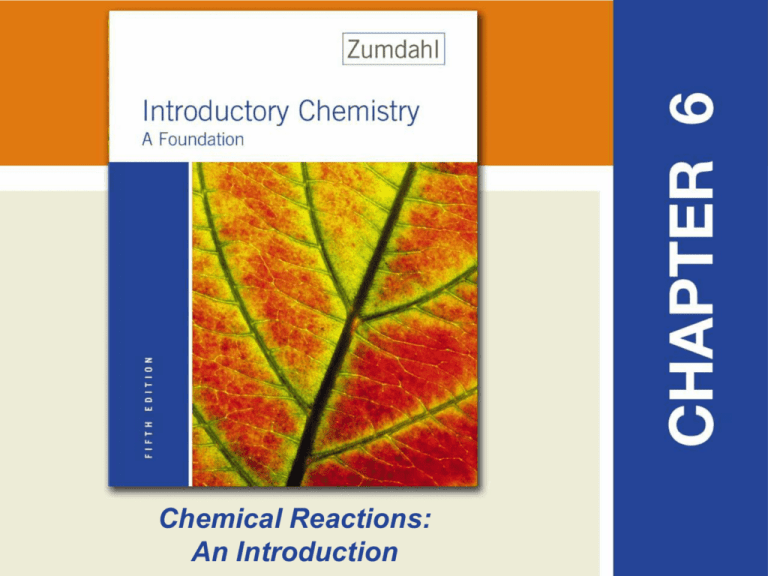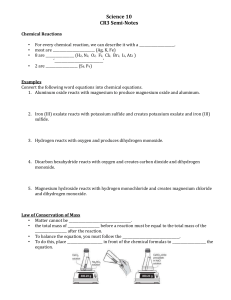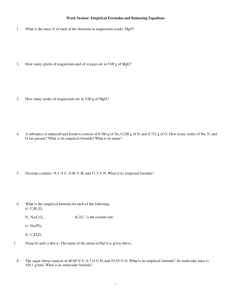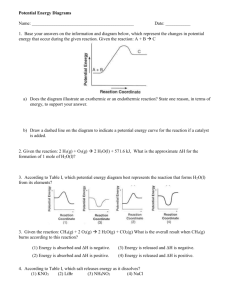
Chemical Reactions:
An Introduction
Chemical Reactions
• Reactions involve chemical changes in
matter resulting in new substances
• Reactions involve rearrangement and
exchange of atoms to produce new
molecules
– Elements are not transmuted during a reaction
Reactants Products
2
Lightning over the town of Tamworth in
New South Wales, Australia.
Source: Gordon Garradd/SPL/Photo Researchers, Inc.
Copyright © Houghton Mifflin Company.All rights reserved.
6–3
Nylon jackets
are sturdy and
dry quickly.
These
characteristics
make them
ideal for
athletic wear.
Source:
C.J. Allen/Stock
Boston
Production of plastic film for use in containers
such as soft drink bottles.
Source: Stephen
Derr/The Image
Bank/Getty
Images
Copyright © Houghton Mifflin Company.All rights reserved.
6–5
Nylon being
drawn from
the
boundary
between
two
solutions
containing
different
reactants.
Evidence of Chemical Reactions
• a chemical change occurs when new
substances are made
• visual clues (permanent)
– color change, precipitate formation, gas bubbles,
flames, heat release, cooling, light
• other clues
– new odor, permanent new state
7
Figure 6.1:
Bubbles of
hydrogen
and oxygen
gas form
when an
electric
current is
used to
decompose
water.
Copyright © Houghton Mifflin Company.All rights reserved.
6–9
An injured girl
wearing a cold
pack to help
prevent
swelling. The
pack is
activated by
breaking an
ampule; this
initiates a
chemical
reaction that
absorbs heat
rapidly,
lowering the
temperature of
the area to
which the pack
is applied.
A hot pack used to warm hands and feet in winter. When the package is opened,
oxygen from the air penetrates a bag containing solid chemicals. The resulting
reaction produces heat for several hours.
Copyright © Houghton Mifflin Company.All rights reserved.
6–11
Figure 6.3a: When colorless hydrochloric acid is added to a red solution of
cobalt(II) nitrate, the solution turns blue, a sign that a chemical
reaction has taken place.
Copyright © Houghton Mifflin Company.All rights reserved.
6–12
Figure 6.3b:
A solid
forms when
a solution
of sodium
dichromate
is added to
a solution
of lead
nitrate.
Figure 6.3c:
Bubbles of
hydrogen
gas form
when
calcium
metal reacts
with water.
Figure 6.3d:
Methane gas
reacts with
oxygen to
produce a
flame in a
bunsen
burner.
Chemical Equations
• Shorthand way of describing a reaction
• Provides information about the reaction
– Formulas of reactants and products
– States of reactants and products
– Relative numbers of reactant and product
molecules that are required
– Can be used to determine weights of reactants
used and of products that can be made
16
Figure 6.4:
The
reaction
between
methane
and oxygen
to give
water and
carbon
dioxide.
Conservation of Mass
• Matter cannot be created or destroyed
• In a chemical reaction, all the atoms present
at the beginning are still present at the end
• Therefore the total mass cannot change
• Therefore the total mass of the reactants
will be the same as the total mass of the
products
18
Combustion of Methane
• methane gas burns to produce carbon dioxide gas
and liquid water
– whenever something burns it combines with O2(g)
CH4(g) + O2(g) CO2(g) + H2O(l)
O
H
H
C
H
H
+
O
O
C
+
O
H
H
O
1C+4H
+
2O
1C+2O +2H+O
1C+2H+3O
19
Combustion of Methane
Balanced
• to show the reaction obeys the Law of
Conservation of Mass it must be balanced
CH4(g) + 2 O2(g) CO2(g) + 2 H2O(l)
H
H
C
H
H
O
+
O
C
+
O
1C + 4H + 4O
O
O
O
O
+
H
H
+
O
H
H
1C + 4H + 4O
20
Figure 6.5: The reactants (a) potassium metal and (b) water.
(c) The reaction of potassium with water.
Copyright © Houghton Mifflin Company.All rights reserved.
6–21
Writing Equations
• Use proper formulas for each reactant and product
• proper equation should be balanced
– obey Law of Conservation of Mass
– all elements on reactants side also on product side
– equal numbers of atoms of each element on reactant side as on
product side
• balanced equation shows the relationship between the
relative numbers of molecules of reactants and products
– can be used to determine mass relationships
22
Zinc metal
reacts with
hydrochlor
ic acid to
produce
bubbles of
hydrogen
gas.
Symbols Used in Equations
• symbols used after chemical formula to
indicate state
– (g) = gas; (l) = liquid; (s) = solid
– (aq) = aqueous, dissolved in water
24
Sample – Recognizing Reactants and Products
•
when magnesium metal burns in air it produces a
white, powdery compound magnesium oxide
– burning in air means reacting with O2
– Metals are solids, except for Hg which is liquid
write the equation in words
– identify the state of each chemical
magnesium(s) + oxygen(g) magnesium oxide(s)
write the equation in formulas
– identify diatomic elements
– identify polyatomic ions
– determine formulas
Mg(s) + O2(g) MgO(s)
25
Balancing by Inspection
Count atoms of each element
a polyatomic ions may be counted as one “element” if it
does not change in the reaction
Al + FeSO4 Al2(SO4)3 + Fe
1 SO4 3
b if an element appears in more than one compound on
the same side, count each separately and add
CO + O2 CO2
1 + 2 O 2
26
Balancing by Inspection
Pick an element to balance
a avoid elements from 1b
Find Least Common Multiple and factors
needed to make both sides equal
Use factors as coefficients in equation
a if already a coefficient then multiply by new
factor
°
Recount and Repeat until balanced
27
Examples
•
when magnesium metal burns in air it produces a
white, powdery compound magnesium oxide
– burning in air means reacting with O2
write the equation in words
– identify the state of each chemical
magnesium(s) + oxygen(g) magnesium oxide(s)
write the equation in formulas
– identify diatomic elements
– identify polyatomic ions
– determine formulas
Mg(s) + O2(g) MgO(s)
28
Examples
•
when magnesium metal burns in air it produces a
white, powdery compound magnesium oxide
– burning in air means reacting with O2
count the number of atoms of on each side
– count polyatomic groups as one “element” if on both sides
– split count of element if in more than one compound on
one side
Mg(s) + O2(g) MgO(s)
1 Mg 1
2O1
29
Examples
•
°
when magnesium metal burns in air it produces a
white, powdery compound magnesium oxide
– burning in air means reacting with O2
pick an element to balance
– avoid element in multiple compounds
find least common multiple of both sides & multiply each
side by factor so it equals LCM
Mg(s) + O2(g) MgO(s)
1 Mg 1
1x2O1x2
30
Examples
•
±
when magnesium metal burns in air it
produces a white, powdery compound
magnesium oxide
– burning in air means reacting with O2
use factors as coefficients in front of compound
containing the element
if coefficient already there, multiply them together
Mg(s) + O2(g) 2 MgO(s)
1 Mg 1
1x2O1x2
31
Examples
•
when magnesium metal burns in air it produces a
white, powdery compound magnesium oxide
– burning in air means reacting with O2
Recount
Mg(s) + O2(g) 2 MgO(s)
1 Mg 2
2O2
Repeat
2 Mg(s) + O2(g) 2 MgO(s)
2 x 1 Mg 2
2O2
32
A bombardier beetle defending itself.
Copyright © Houghton Mifflin Company.All rights reserved.
6–33
Examples
•
Under appropriate conditions at 1000°C ammonia gas reacts
with oxygen gas to produce gaseous nitrogen monoxide and
gaseous water
• write the equation in words
– identify the state of each chemical
ammonia(g) + oxygen(g) nitrogen monoxide(g) + water(g)
write the equation in formulas
– identify diatomic elements
– identify polyatomic ions
– determine formulas
NH3(g) + O2(g) NO(g) + H2O(g)
34
Examples
•
Under appropriate conditions at 1000°C ammonia gas reacts
with oxygen gas to produce gaseous nitrogen monoxide and
gaseous water
count the number of atoms of on each side
– count polyatomic groups as one “element” if on both sides
– split count of element if in more than one compound on
one side
NH3(g) + O2(g) NO(g) + H2O(g)
1 N 1
3H2
2O1+1
35
Examples
•
Under appropriate conditions at 1000°C ammonia
gas reacts with oxygen gas to produce gaseous
nitrogen monoxide and gaseous water
pick an element to balance
– avoid element in multiple compounds
° find least common multiple of both sides & multiply
each side by factor so it equals LCM
NH3(g) + O2(g) NO(g) + H2O(g)
1 N 1
2x3H2x3
2O1+1
36
Examples
•
±
Under appropriate conditions at 1000°C ammonia
gas reacts with oxygen gas to produce gaseous
nitrogen monoxide and gaseous water
use factors as coefficients in front of compound
containing the element
2 NH3(g) + O2(g) NO(g) + 3 H2O(g)
1 N 1
2x3H2x3
2O1+1
37
Examples
•
Under appropriate conditions at 1000°C ammonia gas reacts
with oxygen gas to produce gaseous nitrogen monoxide and
gaseous water
Recount
2 NH3(g) + O2(g) NO(g) + 3 H2O(g)
2 N 1
6H6
2O1+3
Repeat
2 NH3(g) + O2(g) 2 NO(g) + 3 H2O(g)
2 N 1 x 2
6H6
2O1+3
38
Examples
•
´
Under appropriate conditions at 1000°C ammonia gas
reacts with oxygen gas to produce gaseous nitrogen
monoxide and gaseous water
Recount
2 NH3(g) + O2(g) 2 NO(g) + 3 H2O(g)
2 N 2
6H6
2O2+3
39
Examples
•
Under appropriate conditions at 1000°C ammonia gas reacts
with oxygen gas to produce gaseous nitrogen monoxide and
gaseous water
Repeat
– A trick of the trade, when you are forced to attack an element that is in
3 or more compounds – find where it is uncombined. You can find a
factor to make it any amount you want, even if that factor is a fraction!
– We want to make the O on the left equal 5, therefore we will multiply it
by 2.5
2 NH3(g) + 2.5 O2(g) 2 NO(g) + 3 H2O(g)
2 N 2
6H6
2.5 x 2 O 2 + 3
40
Examples
•
Under appropriate conditions at 1000°C ammonia gas
reacts with oxygen gas to produce gaseous nitrogen
monoxide and gaseous water
Multiply all the coefficients by a number to eliminate
fractions
– x.5 2, x.33 3, x.25 4, x.67 3
2 x [2 NH3(g) + 2.5 O2(g) 2 NO(g) + 3 H2O(g)]
4 NH3(g) + 5 O2(g) 4 NO(g) + 6 H2O(g)
4 N 4
12 H 12
10 O 10
41
Decorations on glass are produced by etching
with hydrofluoric acid.
Copyright © Houghton Mifflin Company.All rights reserved.
6–42






